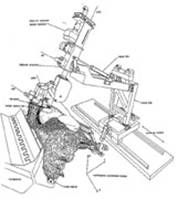Newman Smith High School Robotics Team One Team 07-0071 |
|||||||||
|
Present-Day Agricultural Robotics We have come far from using spears and caschroms as our robots. Nowadays, we use automated irrigation systems (sprinklers), small robots for specific tasks and various other large farming machines.
Another recent invention is that of a cow-milking machine, which allows the cows to decide when they want to be milked, whether they want hot water or cold water, and whether or not they want to be brushed and scratched. This allows farmers to go on vacation without worrying about how the cows will be taken care of. The farmer can monitor the farm from his laptop, cell phone or other electronic device, even while he is on vacation across the world. [20] One of the most recent technological advances in agriculture is the use of GPS. The GPS, or Global Positioning System, uses multiple satellites with known locations to determine the location of the receiver. Some agricultural robots use a teach/playback system, where they are taught a route that they observe with two receivers-- one stationary, and one roving. After learning the path, the robot can be programmed to automatically repeat it. [21] Robots that use GPS units include the Rice-Planting Robot and automated harvesting robots. The Rice-Planting Robot uses tilt sensors and other various instruments, such as GPS, to calculate the movements of the machine, determining where the robot is in the paddy. [15] Automated harvesting robots use the teach/playback system to harvest all crops in a field, using a camera to make sure they haven't already covered that area. [21] Upon the fact that “nearly a third of all crops are damaged by animal or insect pests, diseases, fungi and weeds,” [9] robots have been invented that spray pesticides on crops. A tractor pulls the robot, which sprays pesticides in the areas that need to be rid of pests the most. |
||||||||
